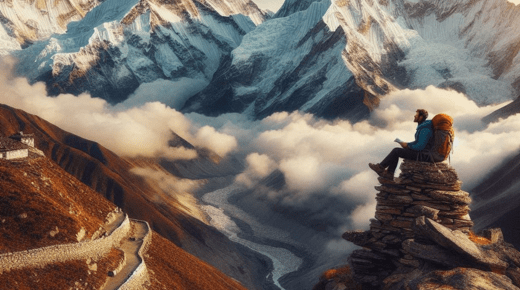Aside from providing invaluable experience and guidance throughout the journey, Sherpas provide expert knowledge and support that significantly enhances the Everest Three High Passes trek experience. Sherpas, the indigenous people of the Everest region, have an innate knowledge of the terrain, weather, and the challenges of high altitude which makes them the most important guides for any hike in the Himalayas.
Everest Three Pass Trek group tour A significant factor in Sherpas improving the trek experience is what they know about the mountains. They know the best routes, the least travel ways, and the least dangerous way at a particular time, especially when crossing the notoriously difficult high passes (Renjo La, Cho La , or Kongma La). Guidance and safety while navigating these arduous terrains help trekkers make their way around without much of any risk or danger of getting lost. Their experience also included a deep knowledge of the weather, knowing which way the winds were blowing and if trekkers could push on or if they would have to stop progressively due to shifting conditions in the mountains.
Besides their actual expertise, Sherpas help trekkers to handle the important physiological phenomenon called acclimatization. Thanks to their extensive knowledge of altitude sickness, as well as the human body’s physiological alterations as they ascend, Sherpas guarantee that trekkers abide by the correct schedule of gradual ascent and rest days, reducing altitude sickness-related risk factors. They provide comfort, encouragement, and the challenge needed to make the journey feel worthwhile despite the physical discomfort.
In addition to logistics and safety, Sherpas offers trekkers an introduction to the rich cultural tapestry of the Everest region. Trekkers also learn from them about their lives, and culture which gives an added layer of enrichment to the physical challenge. From a warm smile and a shared meal to a conversation about local customs, Sherpas ensure that the Everest Three High Passes trek is not just a physical challenge, but a life-enriching experience, leaving trekkers with memories that will last long after they have returned from the wilds of the Himalaya.
Everest Three Passes Trekking 17-day Itinerary
Everest Three High Passes Trek is a famous trek that takes you through the heart of the Himalayas, crossing three of the region’s highest passes: Kongma La, Cho La, and Renjo La. This trip is intended for experienced trekkers preferring to choose a more rugged and wilderness adventure than the customary Everest Base Camp trek. The journey offers trekkers insight into high-altitude terrains, picturesque Sherpa hamlets, and magnificent views of the planet’s highest peaks, including Mount Everest, Lhotse, and Makalu. The trip is physically tough, with climbers slogging up to altitudes of more than 5,000 meters, over gnarly passes, and through long days of walking. Trekking along the way, with the opportunity to experience the culture of the Sherpa people and see ancient monasteries and sacred locations. The breathtaking mountain landscapes, cultural exploration, and physical challenge of high-altitude trekking create an unforgettable part of the Everest Three High Passes Expedition, which is the ultimate trek for experienced trekkers who want a unique adventure in the Himalayas.
What Are Sherpas and Their Role in the Expedition
The Everest Three High Passes Expedition would not be possible without the support of the Sherpas. Indigenous to the Khumbu region in Nepal, Sherpas have an intuitive understanding of the country’s terrain, weather, and high-altitude conditions. They are skilled in climbing rocky slopes, are far more physically fit, and are fantastic operational support for trekkers at high altitudes. Sherpas are a key part of ensuring safety and success for such trips, guiding trekkers, carrying burdensome loads of equipment, and helping climbers acclimatize to the low-oxygen thin air at high altitudes. They also know how to administer first aid and manage altitude sickness, which is common at these heights. Aside from their skills, Sherpas are also part of the expedition culture, sharing their traditions and spirituality. The integration of the local people, the rich cultural environment of the mountains, and the land is another reason why the trek is priceless. The success of any Everest trek depends to a large degree on their dedication to ensuring a smooth and safe journey, and they are often regarded as the backbone of high-altitude expeditions.
Training for the Trek – Fitness and Equipment for Walking Gear
The Everest Three High Passes Expedition is a physically and mentally exhausting trek with high-altitude crossings and unpredictable weather, so it’s very important to prepare properly before heading out. The preparatory phase is the first, in which you need to have incredible physical well-being to prepare yourself for the trek, endurance, strength, vision, and vitality are on top of everything. Cardio training, such as running, cycling, or hiking on steep trails, is important for endurance, while strength training will help you through the uphill and rocky portions of the hike. Moreover, as this trek will have you walking up and downhill for long hours on rocky terrain, it’s very important to strengthen the legs. Acclimatization is also important, so make sure to plan for rest days to allow your body to adjust to the high altitude.
Trekkers need to invest in quality gear that is up to the harsh conditions found in the Everest region. The must-have gear comprises insulated jackets, supportive trekking boots (ankle support preferred), and a solid backpack. You’ll definitely want to wear layers, as day and night temperatures can vary widely. A sub-zero-rated sleeping bag, trekking poles, and a first aid kit are additional must-haves. Pack light but be sure to include everything essential to safety, comfort, and survival. Adequate preparation, in terms of both physical preparation and supplies, will help your trip be a successful and enjoyable expedition.
Review of the Three High Passes
Budget Everest Three Pass Trek Three of the most notable high-altitude passes — Kongma La, Cho La, and Renjo La — are crossed by the Everest Three High Passes Expedition instead of this trek. These passes are located at elevations between 5,360 meters and 5,535 meters offering breathtaking views of the Everest region and its neighboring mountains including Mount Everest and Lhotse and Makalu. Each tour provides its own distinct obstacles, with climbers needing to overcome steep climbs, stony scenery, and highly variable weather conditions. The journey starts with a steady rise to the first pass, Kongma La, and progresses to the high-altitude terrain of Cho La, where trekkers have to carefully cross an ice-covered pass. The final pass of the ascent, Renjo La, is the least crowded and one of the most beautiful, offering views of Everest, Lhotse, and Makalu. The Three High Passes trek also offers stunning views of Sherpa villages, Buddhist monasteries, and glacial lakes, making it a cultural experience as well as a physical challenge. The trek presents both physical challenges and rewards, granting trekkers a sense of accomplishment and an unforgettable adventure in one of the most stunning mountain ranges on the planet.
Overview of the route: the trail starts at Lukla
Everest Three High Passes Expedition Starts in Kathmandu to Lukla Flight. It is the gateway to the Everest region and the start of most treks that pass through the area. From Lukla, trekkers walk towards Phakding and finally up to Namche Bazaar which is the biggest town in the Khumbu region and an important acclimatization point. The route runs through small Sherpa villages where trekkers can experience the local culture and interact with the people. They acclimatize for a few days in Namche Bazaar before heading off towards the high passes (the Kongma La first) and walk over the passes in the following order Kongma La, Cho La, and Renjo La. The path will take you through villages such as Tengboche, Dingboche, Lobuche, and Gorak Shep, each of which provides different views of the mountain ranges around them. Upon successfully traversing all three high passes, the trail moves on toward Everest Base Camp, and it ends with a trek back down to Lukla. This means that you will also be fully immersed in the Everest region, this trek is a fantastic mix of difficult terrain, awe-inspiring views, and cultural experiences.
Crossing Kongma La Pass
Everest Three Pass Trek 2025 At 5,535 meters above sea level, the Kongma La Pass is the highest of the three high passes and one of the toughest stretches of the Everest Three High Passes Expedition. Trekking to reach Kongma La starts from the village of Lobuche, where trekkers have an uphill journey that takes them to the rocky high-altitude pass. The route is littered with boulders and moraine and the higher elevation and thinner air give the ascent a different aspect. It is a steep climb to the top of Kongma La, with truly breathtaking views along the way. The sight from the top is one of the most rewarding parts of the trek. From the pass, trekkers can enjoy sweeping views of Mount Everest, Lhotse, Makalu, and other peaks in the Himalayas. Except for the rocky terrain and the steepness down from Kongma La which requires caution. (Kongma La, a physical test of endurance, is undeniably one of the most rewarding moments of the expedition, as the views are unforgettable upon the successful completion of the pass.)
Establishing Trust and Communication with Your Sherpa
Effective communication and building trust with your Sherpa is crucial for a successful and safe expedition. From the very onset of the journey when you meet your Sherpa and build a rapport, camaraderie, respect, and friendship ensue. You trust Sherpas, who know the terrain and the high-altitude conditions, to guide you through difficult territory.
All this means that you should appreciate that Sherpas, who are responsible for leading your ascent on the mountain, don’t just guide — they also help to preserve your safety and well-being. It’s important to be honest about how your physical condition is, or if you are experiencing any discomforts, or your concerns regarding altitude sickness. In return, the Sherpa will offer guidance on pacing, rest stops and the best routes to take and keep both you and the group on track.
Everest High Passes Trek price On high-altitude treks the specifics of what your Sherpa tells you, as well as how well you listen to their advice, become even more important. They know what to do when they see early signs of altitude sickness and adapt the itinerary if these symptoms appear. By establishing an environment of open communication and trust, you will be more inclined to follow their lead, especially when faced with difficult decisions about pace or navigation. This strong base of trust between you and your Sherpa makes the trek much more enjoyable and allows you to connect with the mountain and experience itself on a much deeper level.
The Role of the Sherpas as Guides and Motivators on the Trail
Along the Everest Three High Passes trek, Sherpas will serve as both your guides and motivators. Guides: Local guides know the Everest region intimately and understand its complex terrain. Sherpas are intimately familiar with the high-altitude terrain, knowing the safest paths to take, the ideal spots to rest, and the secret outcroppings with the best views. Whether they are climbing up jagged, rocky paths or traversing across snow-covered fields, Sherpas know how to keep trekkers on track and out of trouble.
But Sherpas are more than simply guides; they are essential motivators, bringing a sense of encouragement and support when the going gets tough, especially in those trickier sections of the trip. The Everest Three High Passes is one of the strenuous routes, and trekkers might feel tired at times, particularly during the high passes like Renjo La, Cho La, and Kongma La. In these instances, Sherpas can offer mental and emotional encouragement to carry on. Sherpas have a positive attitude and determination to help a trekker do away with moments of doubt and fatigue. They know how hard each step of the trek can be and how much mental fortitude it takes, which makes them great motivators.
They are there for you every step of the way, encouraging you to push forward, behind a screen with a screen name, forming a community that allows you to take this experience that feels like work and make it feel unforgettable. The connection may prove to be one of the best parts of the trip, as, by the end of the trek, trekkers develop one of the strongest bonds with the Sherpa.
Seeing through the lens of Sherpas: The Emotional and Mental Support that they provide in Families
Whenever you are trekking Everest Three High Passes, Sherpas help more in a physical way, but they also support you in a mental and emotional way, which gives you an important boost when you face hurdles in that arduous journey. Trekking at high altitudes can be tiring, physically and mentally, and it’s common for trekkers to feel anxious, isolated, or overwhelmed. Poulin’s role in these moments is not just one of the guide but of the person offering strength and reassurance.
Everest Three Passes trek vs base camp They are able to provide emotional support due to their extensive understanding of the trek, its altitude, and the mental impact such conditions can have on trekkers. Sherpas knows the trek is as much about grit and mental strength as it is about physical endurance. They can quickly see when trekkers are beginning to struggle with mental fatigue, and they provide soothing words, encouragement, and practical advice to help them power through difficult seconds. Be it offering a kind word, sharing a smile, or comforting trekkers that they’re not alone, Sherpas shine when it comes to morale-boosting.
That emotional support trails beyond the trail. Sherpas, in fact, frequently spend time exchanging stories, talking about local culture, and sharing jokes to lessen feelings of isolation in such a remote setting. The trekkers join just the same as their spirit is able to combine emotions with trekkers which leads himtrekkers together to enjoy the journey and make the trek not just about the destination, but about the experience and connection with others.
The Role of Sherpas During Emergencies
They are especially valuable in case of emergency during the Everest Three High Passes trek. With extensive experience in the region and a deep understanding of the challenges presented by high-altitude trekking, they are often the first line of defense in an emergency. If someone has a muscle cramp, altitude sickness, sudden weather conditions, or anything else, Sherpas are trained to get the best treatment for the trekkers.
If altitude sickness sets in, they can quickly identify the symptoms and respond rapidly, typically recommending that trekkers head to a lower elevation or get medical attention. They know when it’s time to stop and when it’s safe to keep going, and they also know exactly how to respond in cases of medical emergencies in far-flung mountain areas. Sometimes, if the conditions become dire enough, Sherpas will also help escort a trekker out by arranging for them to be airlifted, or by walking them down to safety, depending upon the circumstances.
In addition to their practical skills, Sherpas have a calming presence and can make you feel at ease, which is critical during emergencies. Their intimate relationships with the mountains and local communities often mean they have been in touch with local resources and can call for help immediately. Their guidance and expertise serve as the best line of defense in any emergency situation, assuring trekkers that they are always in capable hands, no matter the challenge.
Sherpas: The Unsung Heroes of the Trekking Experience
Further, Sherpas are also an integral part of the Everest Three High Passes trekking experience, allowing trekkers not only to enjoy exploring one of the world’s most beautiful regions but also to explore its history and culture. Sherpas bring a local perspective to the trek that gives them insights from a vantage that is much more than the physical aspects of the journey.
First off, Sherpas are key to traversing the difficult high-altitude landscape. They know the region’s routes, weather patterns, and altitude-related dos and don’ts so well that trekkers will be able to approach each segment of the trek with confidence. Their expert guidance enables trekkers to concentrate on taking in the experience rather than worrying about the dangers of the rugged terrain or unpredictable weather conditions. Read more About Gimkit Join
But the contributions of Sherpas don’t end there. As cultural ambassadors, they acclimatize trekkers to the traditions, history , and lifestyle of the Sherpa people. The trekkers learn about life in the Everest region through stories, customs , and interactions with local villagers. This bond with the locals and the terrain makes the trek far more than an exercise in physical endurance, instead offers a rich cultural experience.
Also, they act as motivators and emotional supporters, raising team spirit and encouragement when the times get hard. Having them there transforms the journey into a group adventure where obstacles are faced together and successes are celebrated as a unit. However, it is not simply their physical prowess that makes Sherpas an integral part of the Everest Three High Passes expedition, but their profound cultural insight, deeply embedded in their fabric as a people.
Conclusion: Why You Need a Sherpa on Your Path
The benefits of having a Sherpa for your Everest Three High Passes trek cannot be overstated. While getting physically prepared, having the right gear and plenty of mental fortitude play a role, it’s the Sherpa who helps ensure the journey is safe, memorable, and ultimately rewarding. It is your experience, their local insight into the mountains, their ability to navigate difficult terrain, and their expertise in dealing with altitude sickness that is critical for trekkers to make it through this challenging journey.
It is not just the technical acumen a Sherpa brings, they provide emotional refuge and soothe trekkers’ fears and discomforts brought about by mental and physical strain on the trek. Whether cheering participants on up tough climbs, serving as cultural guides, or simply sharing a smile and reassuring presence, Sherpas also helps create a positive environment and keep spirits high along the way.
The experience and calm presence of Sherpas are invaluable in times of emergency. Whether it be addressing altitude sickness, injury, or unexpected weather conditions this can help prevent serious complications and ensure trekkers get the care they need. In emergencies, they often find themselves acting as first responders due to their knowledge of the terrain, weather, and available resources.
After all, Sherpas are not simply guides; they are collaborators in a life-changing experience. It is not just the summit, the physical challenge that makes the Everest Three High Passes trek special, but their guidance, cultural knowledge, and support that enriches the experience. They are a vital part of the trek’s success and they ensure that trekkers leave the mountains with not only great memories but a greater respect and understanding of the people who inhabit this remote part of the world.






